The $60 CPU Question: AMD Athlon 200GE or Intel Pentium Gold G5400? A Review
by Ian Cutress on January 14, 2019 8:00 AM ESTGaming: Integrated Graphics
Despite being the ultimate joke at any bring-your-own-computer event, gaming on integrated graphics can ultimately be as rewarding as the latest mega-rig that costs the same as a car. The desire for strong integrated graphics in various shapes and sizes has waxed and waned over the years, with Intel relying on its latest ‘Gen’ graphics architecture while AMD happily puts its Vega architecture into the market to swallow up all the low-end graphics card sales. With Intel poised to make an attack on graphics in the next few years, it will be interesting to see how the graphics market develops, especially integrated graphics.
The two processors on test today have very different attitudes towards integrated graphics. The AMD Athlon 200GE uses the latest Vega architecture, designed for high performance, even if AMD only uses 192 streaming processors in this design. Intel on the other hand is using its older Gen 9 graphics architecture, built for mobile processors, and is using a baseline GT1 configuration when most Intel desktop processors have GT2.
| AMD vs Intel at ~$60 | ||
| AMD Athlon 200GE |
Intel Pentium Gold G5400 |
|
| Cores / Threads | 2 / 4 | 2 / 4 |
| Microarchitecture | Zen | Coffee Lake |
| Motherboards | X470, X370, B450 B350, A320, A300 |
Z390, Z370, Q370 H370, B360, H310 |
| CPU Frequency | 3.2 GHz | 3.7 GHz |
| L2 Cache | 512 KB/core | 256 KB/core |
| L3 Cache | 2 MB / core | 2 MB / core |
| Integrated Graphics | Vega 3 192 SPs |
UHD 610 12 EUs (96 ALUs) |
| DDR4 Support | DDR4-2933 | DDR4-2666 |
| GPU Frequency | Up to 1000 MHz | 350-1050 MHz |
| TDP | 35 W | 54 W (2-core die version) 58 W (4-core die version)* |
| Price | $55 (SRP) | $64 (1k/u) |
| * Intel harvests both 2+2 and 4+2 dies to make G5400 parts. It's impossible to know which one you have without removing the lid and measuring the die area. | ||
Intel does have a small ray of hope here – caches are important when it comes to integrated graphics, so while the 200GE has a bigger L2 cache (512KB vs 256KB) and faster main memory (DDR4-2666 vs DDR4-2400), the AMD L3 cache is a victim cache whereas the Intel L3 cache is a fully inclusive cache that can pre-fetch data. It’s a slim chance, but Intel should take what it can.
For our integrated graphics testing, we take our ‘IGP’ category settings for each game and loop the benchmark round for five minutes apiece, taking as much data as we can from our automated setup.
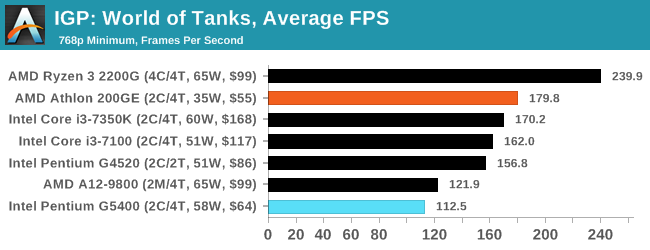

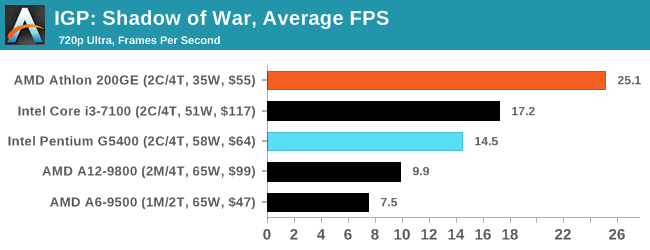
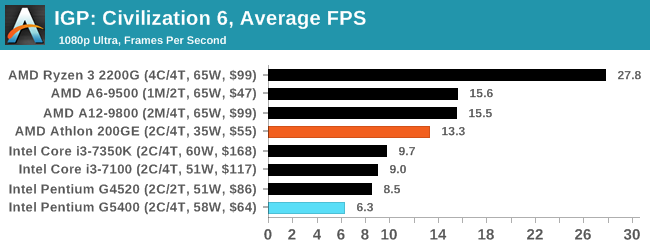
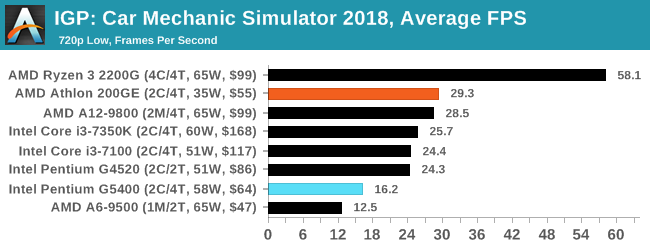
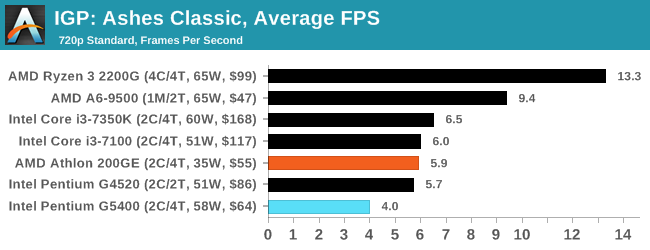

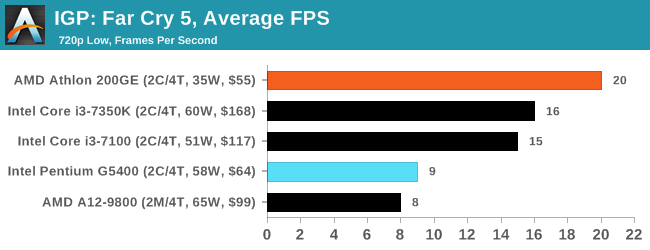
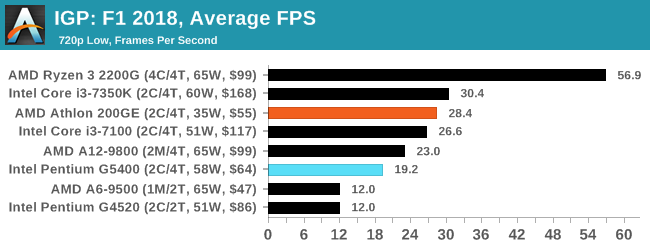
That was a white wash. AMD’s worst win was 48% in both Ashes and F1 2018, while its best wins were in Far Cry 5 at 122.2% and Civilization 6 at 112.1%.


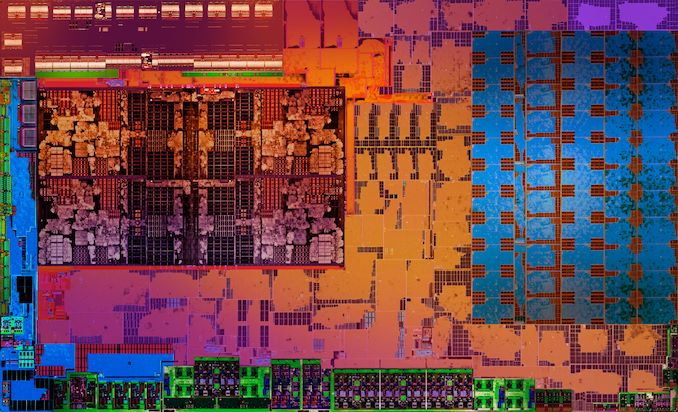








95 Comments
View All Comments
shabby - Tuesday, January 15, 2019 - link
Lol this chip hasn't been $60 for half a year, what was AT thinking writing this article? The intel bias is strong here.yannigr2 - Monday, January 14, 2019 - link
I stopped reading this article when I saw that the Pentium price is NOT based on the ACTUAL price of the processor in the market, but just some marketing/wishful thinking that Intel posts on it's site.Pity. I was expecting more from Anandtech.
mobutu - Monday, January 14, 2019 - link
"In gaming with a discrete graphics card, for example, if you've invested in something like the GTX 1080..."so we're talking about the absolute cheapest of the cheap build but all of the sudden "you invested in a GTX 1080" ?
megaLOL wtf is this
sing_electric - Monday, January 14, 2019 - link
Yeah, that sentence is weird (though I guess, if you have $400 now, you can get a working system with a very solid PSU and the rest of the specs listed here, and if you have money later, plop in a dGPU you actually want, and after that, get the CPU you actually want), but the reason to use a GTX 1080 in the test is that you can be more or less guaranteed that none of the scores you saw were GPU-bound, so you're getting an idea of CPU performance. Otherwise, whatever GPU they chose (1030? 1050? RX 550/560?) would sometimes be the bottleneck, meaning the charts wouldn't tell you anything comparing the two CPUs.drexnx - Monday, January 14, 2019 - link
I think the obvious conclusion from this article is skip both and buy the R3 2200Gshabby - Monday, January 14, 2019 - link
That cpu is still cheaper than the g5400 which costs $130 even at Newegg. Where did Ian get the price of the g5400? It makes this article worthless.sing_electric - Monday, January 14, 2019 - link
Right, I think these processors are aimed more at OEMs trying to hit a price point. The cheapest I can do a reasonable system build around these is $305, in which case, the extra cash to go for the R3 seems like a no-brainer.Even if its an upgrade vs. a new build, you're looking at ~$180 minimum ($60 for the CPU, $60 for the motherboard, since there is basically no way you already AM4/LGA1151 system and look at this as an "upgrade," and that means you probably need new RAM since chances are you're coming from DDR3), in which case, why not spend the extra $30-40 for a significant step up in processor (and, in the case of AMD, one that officially supports overclocking).
piasabird - Monday, January 14, 2019 - link
I would have thrown in the Intel i3 8100 quad core which is selling for $118 on Newegg. It is close to the same price as the i3 7100. If you purchase it at a Micro Center you might get $30 off on a motherboard combo.drzzz - Monday, January 14, 2019 - link
WTF Ian? As of this post the Intel is 183$ follow the link in the article and the AMD is 60$. This is not a even close to comparing 60$ parts. Seriously how did this get by the editors?shabby - Monday, January 14, 2019 - link
The editors were intel...